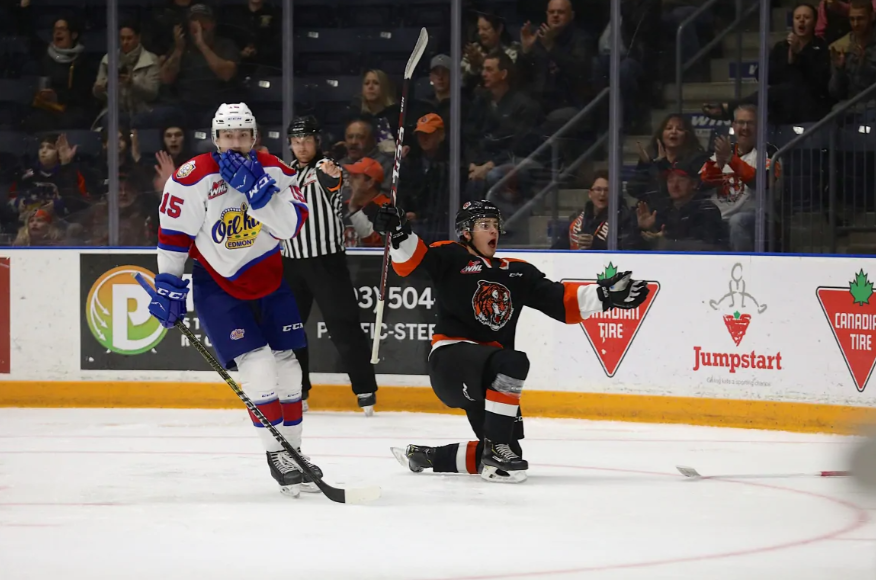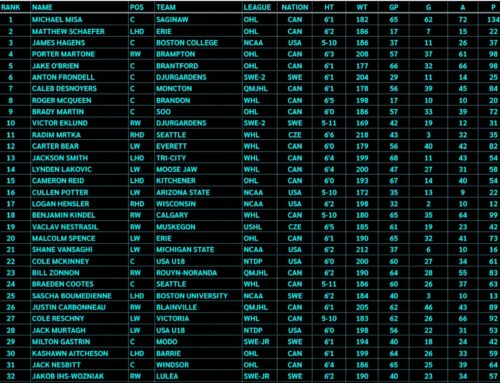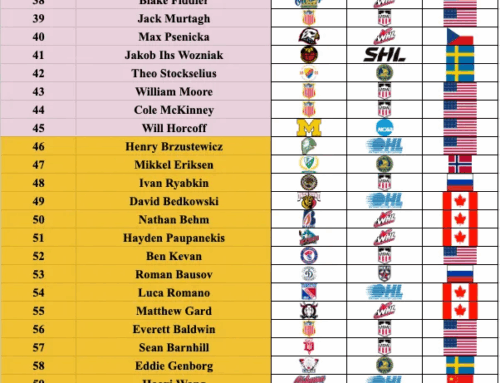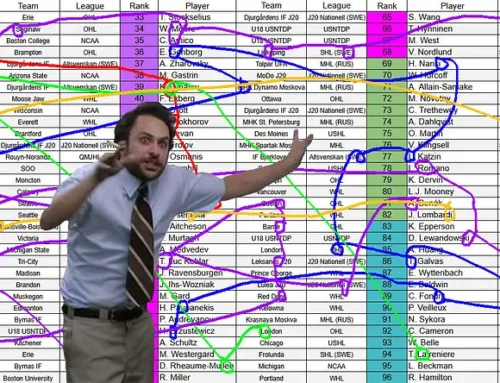USHL Report: March 2021
Hadi Kalakeche
2021-03-15

Photo courtesy of CBC.ca
USHL Monthly Report: Deep dive on Cole Sillinger
Back in November 2020, the WHL season had to cancel the start of their season due to uncertainty surrounding COVID-19 and the risks young student-athletes faced. The USHL, however, had just begun its season, despite the entire country swimming in cases. The Regina-native Cole Sillinger, son of long-time NHLer Mike Sillinger, decided to join the Sioux Falls Stampede full-time and bring his talents South of the border, for the good of his prospective hockey career. The six-foot, 190-pound, goal-scoring center has since accumulated 25 points in 15 games with the Herd, including a whopping twelve even-strength goals.
Such a production has seen him rise in the top 20 of most draft boards, with many scouts betting on his goal-scoring touch and stickhandling to carry at higher levels. This month’s deep dive will serve to evaluate Sillinger’s potential as an NHLer, by evaluating every facet of his game.
Before we get into the analysis, please watch this video report breaking down sequences from four of Sillinger’s USHL games.
Written Analysis
Below you will find the parts of Sillinger’s game that cannot be quantified, explained using the good old, trusty eye-test – if the eye-test means watching each shift multiple times, slowing them down, zooming in on the player for trickier details, then finally confirming more technical aspects with trusted experts.
Skating : D+
Sillinger’s skating immediately struck me as heavy, stompy at times and definitely energy-inefficient. I consulted with current skating instructor and former Toronto Marlies assistant coach Jack Han to further understand the issues with his mechanics, and Han explained quite simply: “Kid is on his heels”.
As we continued, Jack explained how Mark Stone has a similar skating stride to Sillinger, where the heel strikes the ice and holds most of the player’s weight, rather than the toes. This leads to a lot of lost energy; taking that skating stride to the NHL, understandably, takes exceptional effort level. “Stone is a work rate god”, he specified – the exception to the rule.
Han prescribes multiple reps with close support from a skating coach – if Sillinger’s stride improves, the rest of his game should follow, as he will rely less on his energy-saving behavior and become more involved in all areas.
IQ: B
There is a very decent hockey mind available in this draft with Sillinger – he finds teammates all over the ice, keeps his head on a swivel, understands the offensive zone very well, weaves in and out of soft ice with ease, and understands how to retain body positioning in puck battles and offensive rushes. The main detractor to his processing of the game is his lack of speed, which puts him in awkward positions on breakouts, forechecks and rushes.
Mentality: B+
Sillinger really stands out with a snarl to his game that not many forwards can boast in this draft class. He lays the body with regularity, often after something doesn’t go his way. Saved one-timer on the powerplay, missed call by the refs, you name it – a bone-crusher is sure to follow when the young center is on the ice. He gets his teammates riled up often, and has an unshakable confidence that is extremely beneficial to goal-scorers such as himself.
Stickhandling: B+
Sillinger has extremely refined puck skills, able to both protect the puck adequately at all times with his body, and to slide the puck through defenders with ease. His bag of tricks is extensive, boasting between-the-legs toe-drags and all sorts of other skills that throw defenders off course regularly.
Statistical profile
Stats are hand-collected and even-strength only, unless indicated otherwise. Collected using approx. 60 minutes of ice-time at 5v5 over four games.
Shooting: A
- On vs off net: 16-8
- One-timers: 1
- Outside vs. slot: 7-17
- Shooting percentage (Via Pick224, season stats): 24.56%
- Goals: 4
I do not believe there are many better shooters in this draft than Cole Sillinger. He has both the velocity to throw a puck through a screen and goalie from mid-range, and the offensive IQ to show up in dangerous areas at opportune moments. Most of his shots are from the slot, and most of them are on net. That together, combined with his refined shooting mechanics and pre-shot movement, lead to a reliably strong ability to hurl pucks past hopeless netminders. Expect that shooting percentage to drop, though – definitely unsustainable over a full season, as most elite shooters in the NHL hover around the 17% mark.
Passing: C+
- Success rate: 39/55 – 70.9%
- High-danger passes: 4/10 – 40%
- Passes that led to shots (within the next 2 seconds): 2
Only 18% of his pass attempts were dangerous in the four games I tracked. This is because Sillinger does not control the puck often in the offensive zone with the intent to look for teammates, seeking soft ice instead and shooting anytime he can. He does have a wonderful shot, but participating actively in offensive cycles is essential at higher levels of hockey.
Retrievals: B+
- Loose: 26
- Contested: 15-10
Sillinger wins most of his battles, and shows good body positioning and intensity on loose pucks that are within his reach. A lot of his loose puck retrievals came off good stick checking and turnover generation.
Play-driving : C+
(on-ice team stats)
- Passes to slot for vs. against: 16-16
- Shot attempts for vs. against: 50-46
- High-danger chances for vs. against: 25-24
- Turnovers vs. takeaways: 14-14
- Goal share relative to team (via Pick224, season stats) :11.34% (8th among draft year players, min. 15 gp) — Sillinger’s on-ice goal share is 11% better than the team’s overall goal share.
- Goal share (via Pick224, season stats): 62.50% — Sioux Falls scores 62% of all goals that occur with Sillinger on the ice.
Sillinger’s shooting ability and offensive positioning lead to a decent number of chances for, but his slow disposition on the backcheck and defending cycles leads to an almost exact amount and type of chances against. What worries me the most is that he spent a lot of ice-time with Brent Johnson, the USHL leader among draft-year players for generating more scoring chances than his teammates. His skating and effort level are major setbacks that will need to be rectified in order for him to drive play better.
Line carries and transition: C
- Defensive blue line: 14
- Red line: 23
- Offensive blue line: 23
- Three-line carries: 8
- Dump-ins: 13
- Dump-outs: 6
Sillinger will often receive the puck in the bottom half of the neutral zone, skate right in, and challenge the defender and goalie with a deke and/or a shot. Not much use there in terms of facilitating team offense, but there’s always a goal risk when Cole Sillinger shoots a puck.
Defense: C+
- Puck checks: 8
- Body checks: 8
- Blocked passes: 16
- Blocked shots: 2
- Faceoffs: 64%
I was pleasantly surprised with Sillinger’s reactivity when facing opponent rushes. When he is already established as a ‘’third defender’’ in the center role and attempting to disrupt play, he does a good job reading the opponent and blocking their passes. It is only once he needs to back-check or defend in-zone that he becomes a liability. He plays the man well, distributing body checks that often knock the puck loose for a teammate. His proficiency in faceoffs shows that he has the ability to gain body and stick leverage on an opponent with consistency, but lacks the effort level and pace to do so regularly outside of a puck drop.
Conclusion
Cole Sillinger is a great pick for a team that is looking to add goal-scoring, decent size and grit to their lineup, and that has experience with skating development. If the Toronto Maple Leafs get their hands on this young man, the world should watch out – they have worked miracles with their prospects’ skating in the past, and surely have the tools and resources to turn him into a star center. He can play the wing just as well, if the center position turns out to be too much for him. If he does not rectify his skating, however, his positioning will need to come a long way for him to have any impact at the NHL level. His potential alone should see him go in the top 15 in this draft, likely to a team that desperately needs goals like the Devils or the Blue Jackets. If he drops outside that rank, it will be because teams do not see him improving his skating in the next few years, which is just as possible.
Hadi Kalakeche
Follow me on twitter: @HadiK_Scouting






